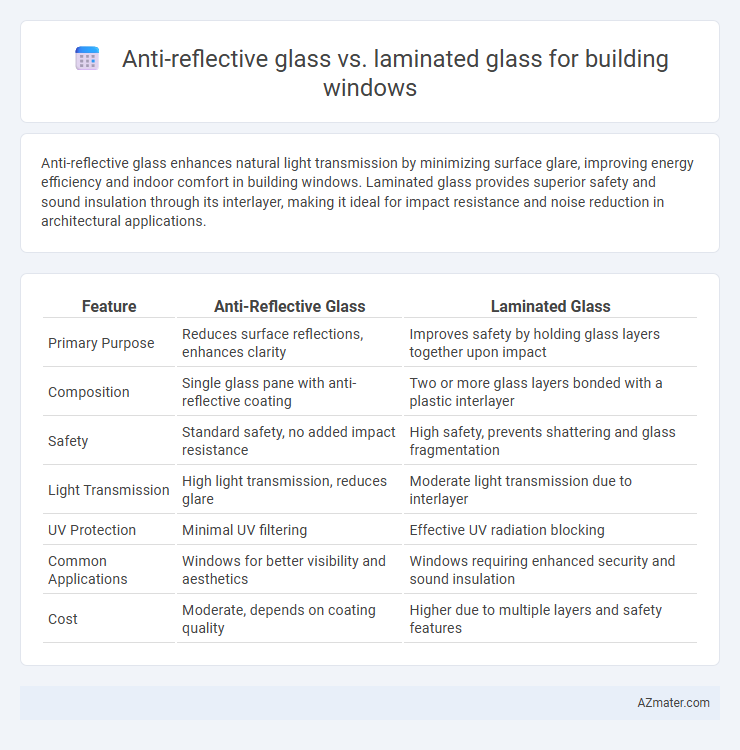Anti-reflective glass enhances natural light transmission by minimizing surface glare, improving energy efficiency and indoor comfort in building windows. Laminated glass provides superior safety and sound insulation through its interlayer, making it ideal for impact resistance and noise reduction in architectural applications.
Table of Comparison
| Feature | Anti-Reflective Glass | Laminated Glass |
|---|---|---|
| Primary Purpose | Reduces surface reflections, enhances clarity | Improves safety by holding glass layers together upon impact |
| Composition | Single glass pane with anti-reflective coating | Two or more glass layers bonded with a plastic interlayer |
| Safety | Standard safety, no added impact resistance | High safety, prevents shattering and glass fragmentation |
| Light Transmission | High light transmission, reduces glare | Moderate light transmission due to interlayer |
| UV Protection | Minimal UV filtering | Effective UV radiation blocking |
| Common Applications | Windows for better visibility and aesthetics | Windows requiring enhanced security and sound insulation |
| Cost | Moderate, depends on coating quality | Higher due to multiple layers and safety features |
Introduction to Building Window Glass Types
Anti-reflective glass for building windows reduces glare and enhances natural light transmission by minimizing surface reflections, improving visibility and energy efficiency. Laminated glass consists of two or more glass layers bonded with an interlayer, offering superior safety, sound insulation, and UV protection while maintaining structural integrity. Selecting between anti-reflective and laminated glass depends on the building's requirements for clarity, safety, and thermal performance.
What is Anti-Reflective Glass?
Anti-reflective glass is specially coated to reduce glare and reflections, enhancing transparency and natural light transmission in building windows. This type of glass improves visibility and visual comfort by minimizing the reflection of sunlight and artificial light. It is ideal for architectural applications where clear views and aesthetic appeal are essential.
What is Laminated Glass?
Laminated glass consists of two or more glass layers bonded with an interlayer, typically polyvinyl butyral (PVB), enhancing safety by holding shards together upon impact. It provides superior sound insulation, UV protection, and security compared to standard glass, making it ideal for building windows requiring durability and safety. Unlike anti-reflective glass, which primarily reduces glare, laminated glass focuses on safety, structural strength, and energy efficiency in architectural applications.
Key Features of Anti-Reflective Glass
Anti-reflective glass in building windows significantly reduces glare and enhances natural light transmission, improving visual comfort and energy efficiency. Its coating minimizes reflection, making interiors brighter and views clearer compared to laminated glass, which primarily offers impact resistance and safety through a plastic interlayer. Anti-reflective glass is ideal for commercial and residential buildings where maximizing daylight and reducing eye strain are top priorities.
Key Features of Laminated Glass
Laminated glass consists of two or more glass layers bonded with an interlayer, providing enhanced safety by preventing shattering upon impact, making it ideal for building windows requiring security and durability. Its sound-insulating properties and UV filtration contribute to improved indoor comfort and protection against harmful rays. Laminated glass also offers excellent resistance to weather conditions and increased structural integrity compared to standard anti-reflective glass.
Optical Clarity: Comparing Anti-Reflective and Laminated Glass
Anti-reflective glass offers superior optical clarity by minimizing glare and reflections, ensuring maximum light transmission and unobstructed views in building windows. Laminated glass, while providing enhanced safety and sound insulation through its interlayer, often exhibits slight optical distortions and reduced clarity compared to anti-reflective coatings. Choosing between these types depends on prioritizing visual transparency versus safety features in architectural applications.
Safety and Security Considerations
Anti-reflective glass enhances visibility and reduces glare but offers limited impact resistance, making it less effective for security against forced entry or severe weather. Laminated glass consists of multiple layers bonded with an interlayer, providing superior safety by holding shards in place upon breakage and improving resistance to impact and burglary. For building windows where safety and security are paramount, laminated glass is the preferred choice due to its ability to prevent injuries and deter intrusions effectively.
Energy Efficiency and UV Protection
Anti-reflective glass enhances energy efficiency by minimizing light reflection and maximizing natural daylight penetration, reducing the need for artificial lighting and lowering HVAC costs. Laminated glass offers superior UV protection by incorporating a polyvinyl butyral (PVB) interlayer that blocks up to 99% of harmful UV rays, preventing interior fading and material degradation. Combining anti-reflective and laminated glass technologies can optimize building performance by balancing energy savings with effective UV shielding.
Cost Comparison and Long-Term Value
Anti-reflective glass typically costs 20-30% more than laminated glass due to its specialized coatings designed to reduce glare and improve visibility. Laminated glass, while often cheaper upfront, provides enhanced safety and soundproofing benefits, contributing to greater long-term value in environments prone to impact or noise. Considering lifecycle costs, laminated glass offers superior durability and maintenance savings, whereas anti-reflective glass adds value through improved energy efficiency and occupant comfort.
Choosing the Right Glass for Your Building
Anti-reflective glass enhances natural light transmission by reducing glare and reflections, making it ideal for buildings prioritizing energy efficiency and visual comfort. Laminated glass offers superior safety and sound insulation through its layered structure, providing impact resistance and security benefits. Selecting the right glass depends on balancing factors such as light clarity, safety requirements, and noise reduction needs for optimal building performance.

Infographic: Anti-reflective glass vs Laminated glass for Building window
 azmater.com
azmater.com